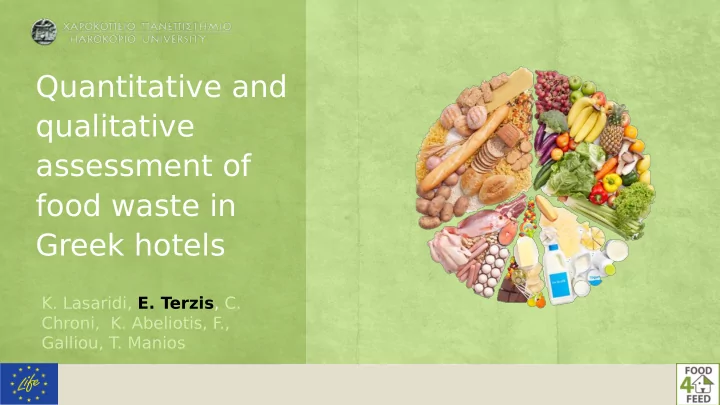

Quantitative and qualitative assessment of food waste in Greek hotels K. Lasaridi, E. Terzis , C. Chroni, K. Abeliotis, F ., Galliou, T. Manios
Food waste is an issue that afgects all aspects of society– producers, growers, retail, hospitality, consumers and those who experience food poverty.
Food waste in Greece In Greece, an estimated 1.85 million tonnes of food is discarded every year. The cultivation, processing, transport and disposal of this wasted food costs to the citizens of Greece 3 billion euros. An estimated 430,000 tonnes of food waste is produced annually by businesses in Greece. Of these, more than 380,000 tonnes come from commercial enterprises (hotels, restaurants, food retail and wholesale, etc.), while about 50,000 tonnes are produced by the food processing industry. It is estimated that the annual cost for the collection and management of the 380,000 tonnes of food waste amounts to 60 million euros.
Selected hotels in the targeted area (Heraklion-Hersonissos) The area of the targeted 4 and 5 star hotels
Illustration of the food waste source separation scheme
Qualitative and quantitative analysis of hotels’ food residues
Qualitative analysis • The compositional analysis was executed through Waste Analysis Campaigns (WACs) prior to solar drying/ pasteurisation. The fjrst waste collection and analysis campaign (compositional analysis and microbiological investigation) of the project took place during Autumn 2017 and another one followed in Spring/ Summer 2018 (May/June 2018). In Summer 2018 (July/ August), the third waste analysis campaign took place. The fourth and last waste analysis campaign (WAC) took place on the last week of Autumn 2018 (September/ October). During this period food residues from four hotels were collected and the seasonal composition of the food residues was determined.
Compositional Analysis
Compositional Analysis Avoidable waste
Compositional Analysis
Physicochemical parameters of hotels’ food waste Minimu Parameters Unit Mean (±s) Maximum m Moisture % w/w 77.30 (±5.19) 69.98 84.65 Density Kg m -3 569.3 (±48.8) 518.5 638.2 pH - 4.85 (±0.23) 4.60 5.20 Ash % w/w 5.9 (±1.37) 4.99 8.26 Crude protein g/kg DM 283.3 (±39.5) 202.00 303 Crude fat g/kg DM 201.3 (±30.5) 164.00 248.00
Physicochemical parameters of hotels’ food waste, cont.… Minimu Parameters , cont Mean (±s) Maximum m Crude fjbre g/kg DM 33.6 (±7.0) 21.60 38.60 Ca g/kg DM 7.78 (±2.70) 4.81 11.57 P g/kg DM 3.00 (±0.32) 2.77 3.55 K g/kg DM 8.60 (±0.33) 6.92 12.60 Mg g/kg DM 0.91 (±0.18) 0.72 1.16 Na g/kg DM 7.83 (±0.1.37) 5.58 9.26
Qualitative analysis results The analyses of the source separated food waste revealed the principal food waste categories found in collected food waste per season. The average values are: Cooked meals: 27.1% Bread and bakery products: 5.7% Meat and fjsh: 5.0% Fresh Fruit and fresh Vegetables & salads waste: 56,5% The ‘Fresh Fruits’ and ‘Fresh Vegetable and Salads’ represented the greatest proportions in each WAC for the four hotels. A certain degree of variability is observed though due to seasonal variation.
Quantitative analysis of hotels’ food residues •
Main fjndings: The analyses of the source separated food waste revealed the principal food waste categories found in collected food waste per season. The average values are: Cooked meals: 27.1% Bread and bakery products: 5.7% Meat and fjsh: 5.0% Fresh Fruit and fresh Vegetables & salads waste: 56,5% The ‘Fresh Fruits’ and ‘Fresh Vegetable and Salads’ represented the greatest proportions in each WAC for the four hotels. A certain degree of variability is observed though due to seasonal variation. Absence of Salmonella spp., it is observed in all samples.
Thank you for your attention!!!
Recommend
More recommend